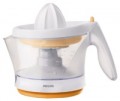Juice container
The volume of the built-in or freestanding juice tank (see Juice capacity). It is usually in the range from 0.2 to 2 liters. Doing more volumes, usually, does not make sense — freshly squeezed juice is considered the most useful, and it quickly loses its properties. Therefore, the best option is to prepare small portions of juice
up to 1 liter, with the expectation that you can drink it right away. On the other hand, for the preparation of canned juices,
a tank volume of 1.5 – 2 liters is usually quite enough.
Power
The power of the juicer depends on its type. For example, the power of citrus juicers rarely exceeds 40 W, since the structure of citrus fruits is easily destroyed and does not require serious effort to extract juice.
The power of centrifugal juicers can even exceed 1000 W. The centrifugal speed and spin features depend on the power of the centrifugal juicer (for more details, see Number of speeds)
Functions
—
Blender module. The blender module typically consists of a specialized container with a sharp rotating blade inside, which is placed on the juicer. This enables you to utilize the appliance for tasks such as chopping ingredients, pureeing, crushing ice, and so on.
—
Coffee grinder module. A special attachment that allows you to use a juicer for grinding coffee. The grinding attachment typically consists of a container that is equipped with a grinder and is placed on top of the machine, so that the motor of the juicer powers the blades of the grinder.
—
Automatic pulp ejection. In cases where a dedicated container is provided for the extracted pulp (as indicated by the "Volume of the pulp tank"), the process of discharging the pulp from the juicer separator at the end of the extraction can be automated. This means that the user is not required to manually clean the pulp separator and can simply dispose of the contents of the detachable container.
—
Drop-stop system. In some juicers that feature a separate juice container, the spout or channel used for dispensing the juice may be designed to rotate. This allows the spout to be turned upwards, preventing any remaining drops of juice from dripping onto the table after the device has been used.
—
Foam separator. Due to
...the high speed of the juicers, foam often forms in the finished juice. In some models, the prepared juice tanks (both built-in and freestanding) can be equipped with devices for separating the foam from the juice.
— Soft start. There is a mode in which the motor of the juicer gradually gains speed upon being turned on, as opposed to a sudden jolt. This smooth acceleration helps prevent juice from splashing and also reduces wear and tear on the motor during operation.
— Adjustment of the amount of pulp. Certain types of citrus juicers come equipped with a feature that enables users to adjust the pulp content of the resulting juice. This is made possible through the use of a filter grate positioned beneath the conical nozzle, which allows for the size of the holes to be adjusted. The holes can be set to a small size to minimize the amount of pulp that enters the juice, or to a larger size for maximum pulp inclusion.
In centrifugal juicers, there is no adjustment of the amount of pulp as a separate option — it is carried out by changing the speed of rotation of the centrifuge.
— Pressing mechanism. Citrus juicers may feature a mechanical press designed to push the fruit against the conical nozzle. This eliminates the need for users to hold the fruit by hand and typically results in a more comfortable and efficient extraction process.
— Overheat protection. Juicer motor protection system that turns off the power when the load on the device increases critically and the motor overheats. Particularly useful if the device is to be used for the processing of solid products.
— Switch-on protection. Juicers often include a safety feature that prevents the device from turning on in abnormal conditions, such as when the lid is open. This protection is typically achieved by disabling the power button until the juicer is fully operational. This feature is particularly beneficial for households with young children.Compartment for cord
A special compartment in the body of the device for storing the power cord. Often such compartments are also equipped with devices for uniform winding of the wire, which prevents bending and possible fractures.
The cord compartment is especially useful if the juicer is used relatively rarely and is left idle for a long time outside the kitchen.

